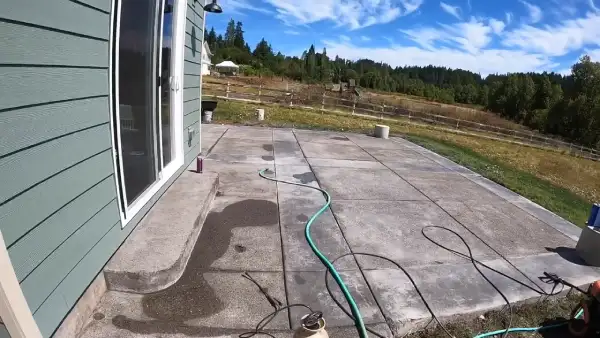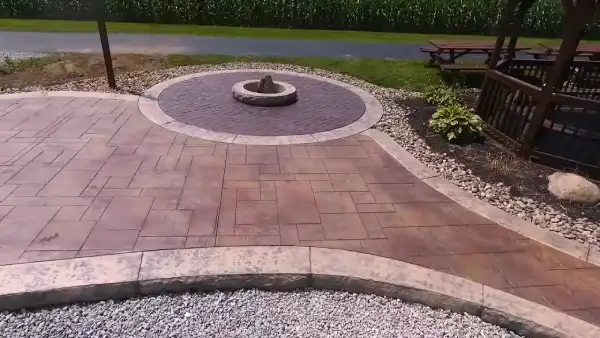Last Updated on February 6, 2023
When it comes to removing concrete sealer, one of the most popular methods is muriatic acid. Muriatic acid can be a cost-effective and relatively easy solution to remove sealant, however, there are some drawbacks and preparations that you should be aware of before attempting this task.
In this blog post, we will discuss the pros and cons of using muriatic acid to remove concrete sealer, as well as the necessary preparations required for its successful use.
By looking into the hazards associated with muriatic acid and understanding how to safely utilize the chemical, you can make an informed decision on whether or not it is the right choice for your project.
Does Muriatic Acid Remove Concrete Sealer: Pros and Cons

Benefits/Advantages
Cost-Effective Solution:
Muriatic acid is a highly cost-effective solution when it comes to removing concrete sealer. It is often used in place of other more expensive and time consuming solutions such as poultice or sandblasting.
Muriatic acid can be found at most hardware stores for a fraction of the cost compared to other removal methods, making it an ideal choice for someone who is looking to save money in the long run.
Additionally, muriatic acid works quickly and effectively, meaning that the project may be completed much faster than if another removal method was used. This can lead to significant savings in labor costs. Lastly, since muriatic acid is an extremely versatile chemical, it can be used on various types of sealer and concrete surfaces with great results.
Easy to Use:
Muriatic acid is easy to use when it comes to removing concrete sealer. It is generally available in liquid form, making it simple and straightforward to apply as needed. Furthermore, the application process itself does not require any specialized tools or training; all one needs are some old clothes and protective eye-wear.
As such, it makes a great choice for any DIY enthusiast who wishes to tackle this project on their own without having to pay for additional labor costs.
Additionally, since muriatic acid works quickly and effectively there is no need for extensive preparation before beginning; this allows one to start the job immediately without delays caused by other removal methods which might take significantly longer periods of time to set up properly before being able to begin the actual process of removal.
Quick Removal Process:
Muriatic acid offers a quick removal process when it comes to removing concrete sealer. The chemical reaction which occurs between the muriatic acid and the sealant often breaks down the sealant into small particles which can then easily be scraped away from the surface of the concrete.
This helps ensure that none of the harder-to-remove residue remains behind after completion of the job; thus leaving behind a clean slate upon which new materials may be applied as needed.
Furthermore, due its ability act fast, muriatic acid offers one more control over how much of the material needs removed depending on how long it left applied for ensuring that only those areas needing removed are removed while allowing other sections remain intact if desired thereby allowing individuals greater flexibility in how they approach each situation accordingly based on their specific needs at hand.
Drawbacks/Disadvantages
Potential Damage to Surrounding Areas or Surfaces
Using muriatic acid to remove concrete sealer can be a hazardous task due to its potential damage to surrounding areas or surfaces. The acid is extremely corrosive and caustic, making it capable of damaging organic materials such as skin, clothing, metal, and stone.
Muriatic acid can quickly break down non-metallic materials such as paint, plastic, rubber, and sealants leading to destruction of the surface that it is applied on.
As such, there must be an extreme amount of caution when using muriatic acid as it has the capacity to cause permanent damage if not handled correctly. Therefore, before attempting any concrete sealing tasks with muriatic acid, one must make sure they are wearing proper safety gear such as gloves and goggles in order to protect themselves from potential harm.
Furthermore, the area being worked on should be clear of any surrounding materials so that no collateral damage will be caused by the chemical’s application.
Risk of Injury from Handling Muriatic Acid
Using muriatic acid for concrete sealing tasks also carries with it a risk of injury for those involved in its handling process. Ingestion of even small amounts can cause severe burns inside the mouth and esophagus; inhalation can lead to irritation in the lungs; and contact with eyes or skin can cause immediate burning pain followed by redness or discoloration at the site of contact.
It is also important to take note that these risks are magnified when using higher concentrations of muriatic acid so caution should always be taken when handling this hazardous material.
To minimize these risks further, it is important for anyone handling this substance to wear protective gear such as eye protection, gloves and long-sleeved clothing while working with muriatic acid in order to reduce their chances of being harmed by it during its use.
Difficulty in Cleaning up Afterward
Due to its hazardous nature, cleaning up after using muriatic acid requires extra time and effort as compared to other methods used for removing concrete sealer from surfaces. It is necessary for users to neutralize any leftover residue from muriatic acid with baking soda solution before disposing off properly since otherwise this residue could still potentially harm anyone coming into contact with it later on down the line.
Furthermore, since muriatic acid reacts strongly with other substances such as bleach which could lead to dangerous reactions if handled incorrectly or incompletely cleaned up afterwards; these substances must also be avoided as much possible during clean up processes afterwards in order prevent any unforeseen accidents from happening down the road .
All these additional precautions add on more time needed for proper handling which makes using this method more time consuming than others available
Preparations for Using Muriatic Acid to Remove Concrete Sealer

Preparing the Area for Application
Taking Safety Precautions: Eye Protection, Gloves, etc.
It is essential to take safety precautions when using muriatic acid to remove concrete sealer. This includes wearing protective gloves and eye protection in order to prevent any contact with skin or eyes respectively.
Additionally, it is important to ensure that the space being used for the application is well ventilated in order to prevent any fumes from building up and causing respiratory problems.
Ventilating the Space and Covering Any Areas that Should Not Come in Contact with the acid
Before beginning the process of removing a concrete sealer with muriatic acid, it is necessary to ventilate the space and cover any areas that should not come into contact with the acid, such as furniture or flooring.
Opening windows and doors will also help circulate air which can reduce any strong odors from forming due to the chemical reaction between the acid and sealant being removed.
Applying a Protective Coating Over Surrounding Areas Nearby the Sealant that is Being Removed
It is suggested that one apply a protective coating on surrounding areas near where they will be removing the concrete sealer with muriatic acid in order to protect those areas from coming into contact with this corrosive substance as well as other debris created when taking off the sealant.
This can include layering on a coat of paint or varnish on exposed surfaces before beginning work and then washing it off thoroughly once finished.
Mixing the Muriatic Acid Solution for Application
Understanding Proper Dilution Ratios for Effective Removal
Before using muriatic acid to remove concrete sealer, it is important to understand proper dilution ratios for effective removal. The ratio between muriatic acid and water should be 1:10 which means that for every gallon of water, one quart of muriatic acid should be used.
This ratio can be adjusted depending on the severity of the staining or the strength of the concrete surface. It is important to remember that using too much muriatic acid can damage the concrete surface and negatively affect its longevity.
Ensuring that Suitable Containers are Used for Mixing and Storage
When mixing and storing muriatic acid solution, it is essential to use containers that are suitable for this purpose. Typically, plastic containers such as buckets or sprayers are used because they are more resistant to corrosion than metal containers.
Additionally, these containers should be clearly labeled with a warning label and kept in a well-ventilated area away from children and pets. It is also important to ensure that any spills are properly cleaned up in order to avoid any potential harm or danger.
Making Sure That All Necessary Tools are Available Before Beginning
Before beginning the process of using muriatic acid to remove concrete sealer, it is essential to make sure that all necessary tools are available beforehand. This includes items such as measuring cups, sprayer bottles, buckets, brushes, towels etc., which will help in properly diluting and applying the solution.
Furthermore, safety gear such as gloves and goggles should also be worn while handling the acidic solution in order to protect against any potential harm or danger caused by splashes or fumes emitted from the mixture.
Is concrete sealer permanent?

Generally, no – concrete sealer is not a permanent solution when it comes to protecting and enhancing your concrete floors or surfaces.
Over time, the sealer will wear off due to foot traffic, UV exposure and other environmental factors. Depending on the type of sealer, some may last longer than others and may need to be reapplied every few years in order to maintain its effectiveness.
How long does it take for concrete sealer to wear off?
This will vary depending on the type of sealer used and the amount of foot traffic and exposure it receives. In general, most concrete sealers will need to be re-applied every two to five years in order for them to remain effective at protecting your floor from water damage and staining.
Can you use acetone on concrete sealer?
Acetone can effectively remove certain types of concrete sealers however it is not recommended for removing all types of concrete sealers. You should always check the manufacturer’s instructions before using any kind of solvent or chemical on your concrete surface so you are aware of any potential hazards associated with their use.
Additionally, acetone should never be mixed with other chemicals as this could create an unsafe situation for you and those around you.
Conclusion:
In conclusion, muriatic acid can be an effective way to remove concrete sealer when used properly; however, it is important to consider both the advantages and disadvantages before deciding if it is the best method for your particular situation.
Before application, take all safety precautions necessary and properly ventilate the space in which you are working. Additionally, make sure to cover any nearby areas that should not come in contact with the acid.
It is also important that you educate yourself on proper dilution rates so that you are able to mix a safe solution for application. With knowledge about both how muriatic acid works and how to use it effectively and safely, you can decide if this method is right for your needs.


